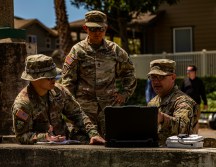Leading the charge: Transforming US Army systems through digital engineering

The U.S. Army faces a critical challenge in the immediate and near-future: the efficient modernization of existing systems to meet the demands of an ever-evolving threat landscape. Traditional methods to solve that challenge no longer suffice in a rapidly advancing technological era, which means the Army must embrace innovative approaches to ensure it remains agile, adaptable and ready for any potential engagement.
Presently, the U.S. Army employs a vast array of systems of which many have been in service for decades. While these systems are fully capable today, there are many challenges in updating them to keep pace with emerging technologies and evolving mission requirements. Traditional approaches to modernization often involve lengthy procurement cycles, inefficient interoperability of proprietary systems, and fragmented technology insertion processes. This results in inefficiencies, expense and limited interoperability between systems, hindering mission readiness. The industrial base must do better.
The Army is already shifting to digital engineering combined with technology-agnostic open integration, complementing the recent Department of Defense Digital Engineering Directive. Digital engineering involves the use of advanced modeling, simulation and data analytics to design, analyze and optimize complex systems throughout their lifecycle. By adopting digital engineering practices, we can streamline development processes, improve collaboration between stakeholders and accelerate the delivery of cutting-edge capabilities to the warfighter.
Furthermore, embracing technology-agnostic open integration allows users to break free from vendor lock-in and proprietary solutions. Instead of being tied to specific vendors or platforms, we can leverage open standards and interoperable architectures to seamlessly integrate components from multiple sources. This not only enhances flexibility and choice but also fosters innovation and competition across the defense ecosystem.
Implementing digital engineering and open integration is not without its challenges. One major obstacle is the prevalence of closed architectures and proprietary systems within the ecosystem. Many legacy systems were developed using vertically integrated proprietary technologies, making them difficult to integrate with other systems.
Vendor lock-in is another significant barrier to overcome. Original Equipment Manufacturers often design their systems with proprietary interfaces and protocols, making it challenging to swap out components or integrate third-party solutions. This limits the ability to leverage the best technologies available and hampers interoperability between systems.
Additionally, the lack of common terminology and frames of reference in the design and build of systems can impede collaboration and hinder progress. Without standardized language and processes, stakeholders may struggle to communicate effectively and align their efforts towards common objectives.
To overcome these obstacles, enabling technologies such as artificial intelligence (AI) and multi-cloud environments can enhance a digital engineering approach. AI can help automate and optimize various aspects of the digital engineering process, from design and analysis to testing and validation. By harnessing the power of AI, we can accelerate decision-making, identify potential issues early in the development cycle and optimize system performance.
Additionally, embracing multi-cloud environments allows solution providers to take advantage of the scalability, flexibility and resilience offered by cloud computing without concern over switching costs. Distributing workloads across multiple cloud providers helps avoid vendor lock-in and ensures redundancy and availability in systems. This also enables industry to leverage best-of-breed services from different cloud providers, maximizing innovation and cost-effectiveness.
The implementation of digital engineering combined with technology-agnostic open integration is essential for the efficient modernization of existing systems. By embracing these principles, industry partners can help the Army overcome the challenges of closed designs, vendor lock and lack of common terminology, while leveraging enabling technologies such as AI and multi-cloud environments to drive innovation, modernize legacy systems and maintain the military’s technological edge on the battlefield.
As stated by the Defense Acquisition University, digital engineering is an “integrated digital approach that uses authoritative sources of system data and models as a continuum across disciplines to support lifecycle activities from concept through disposal.” It is imperative that we embrace digital engineering as a cornerstone of our modernization efforts. Together, we can ensure that the U.S. Army remains the most advanced and lethal fighting force in the world.
Josh Jackson is Executive Vice President of the Army Business Group at SAIC.






